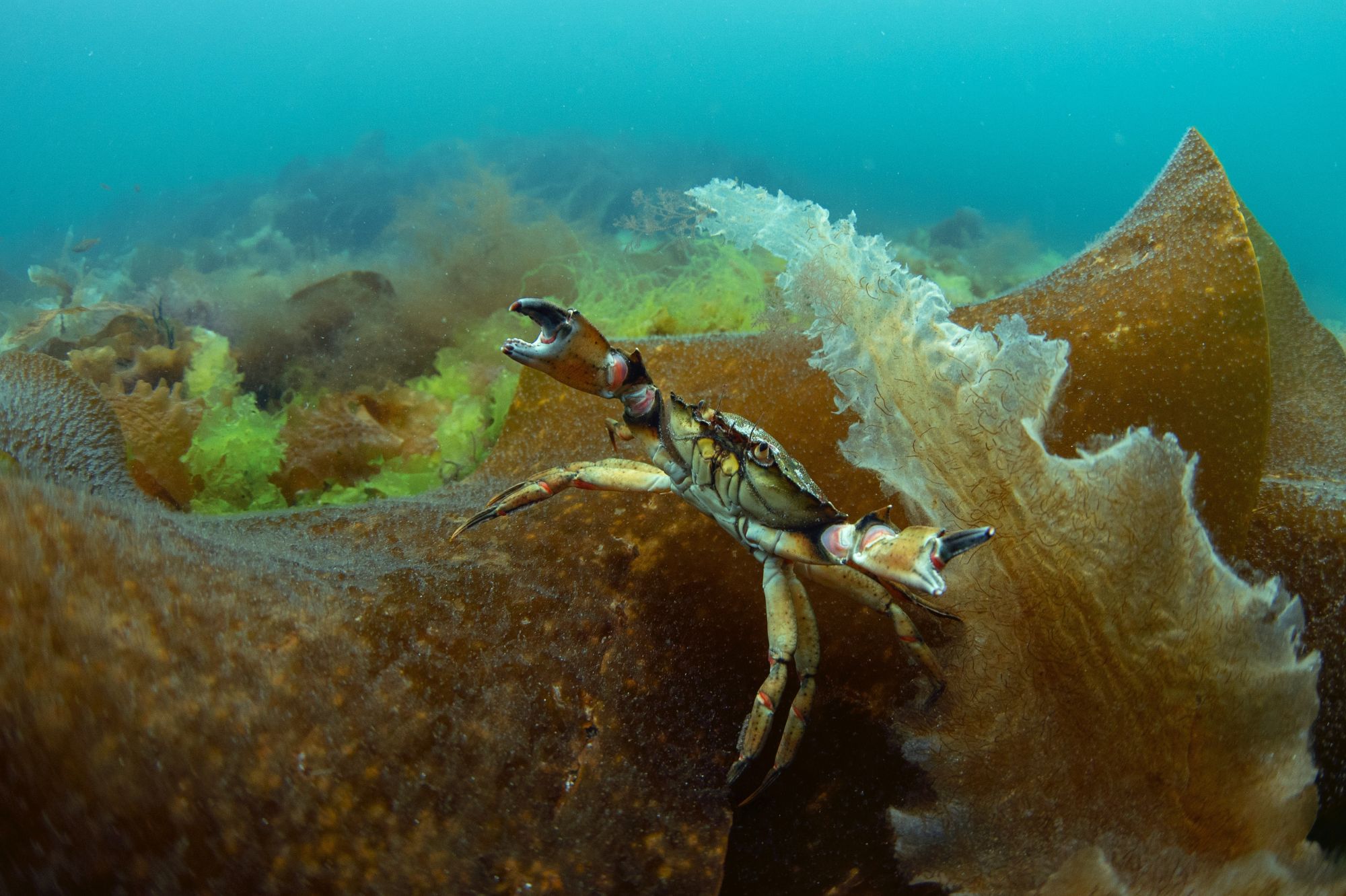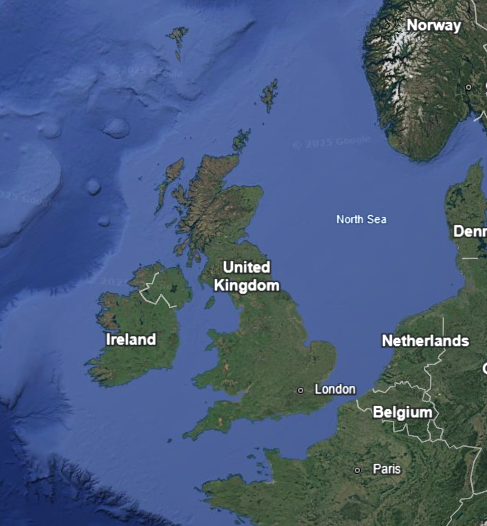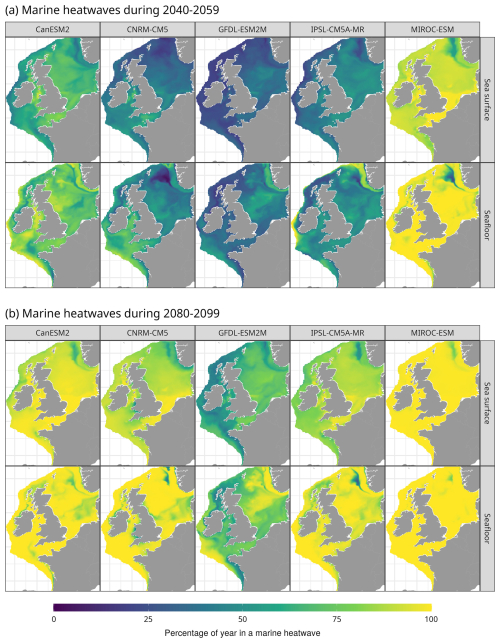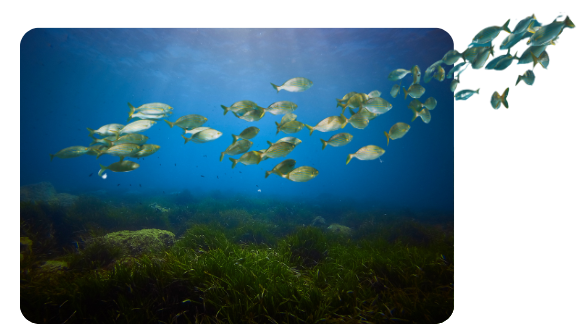Story
Deep trouble – future seafloor marine heatwaves will surpass surface extremes
19 August 2025
A new study shows that marine heatwaves on the seafloor could be more than 50% more frequent in future than at the surface of the ocean during hot summer months, a concerning prospect for bottom-dwelling species that cannot escape the rising temperatures, with ripple effects across entire ecosystems and humans alike.

What is a marine heatwave? A period lasting at least 5 days where sea temperature is greater than the 90th percentile of historical temperatures for that time of year.
Led by PML’s Dr Robert J. Wilson, the study investigated how marine heatwaves will change in the future on the northwestern European shelf, a vital marine ecosystem that provides ecological, cultural and economic services to many countries.

Image: The northwestern European shelf – a broad shallow-water region of the northeast Atlantic that includes several interconnected seas and coastal zones. Image credit: Google Search Engine.
The northwestern European shelf is typically defined more by seabed topography (shallow continental shelf waters) than by strict political or oceanographic boundaries, and generally includes:
- North Sea – between the UK, Scandinavia, Germany, the Netherlands, Belgium, and France
- English Channel – between southern England and northern France
- Celtic Sea – southwest of Ireland and west of Cornwall
- Irish Sea – between Ireland and Great Britain
- Bay of Biscay – off the western coast of France and northern Spain
- Parts of the Norwegian Sea – particularly its shallower southern/shelf-edge areas
- Shetland–Orkney waters and surrounding shelf areas north of Scotland
It is one of the world’s most heavily fished regions and also has the world’s fastest growing offshore wind industry. Understanding how climate change will impact the region is therefore critical to enable effective spatial and fishery management into the future.
Marine heatwaves – periods when ocean temperatures are unusually high for that time of year – are becoming more frequent and severe due to climate change. These extreme events harm ocean life by pushing temperatures beyond what many species can tolerate. Negative impacts on seaweeds, seagrasses, seabirds, coral reefs, crustaceans, fish and plankton, among others, have been recorded.
The impacts of marine heatwaves on the sea surface and seafloor are likely to be distinct. Pelagic species (those which live in the open ocean) can usually swim across large regions and can therefore acclimatise – or reorganise – in response to climate change relatively quickly. However, in contrast, organisms living on the seafloor have limited mobility and are therefore more likely to suffer negative impacts.
Until now, most studies have focused on heatwaves at the ocean surface, but little has been known about what may happen on the seafloor in the future. Using state-of-the-art regional climate models, Dr Wilson and colleagues from Plymouth Marine Laboratory and the National Oceanography Centre found that heatwaves will become much more common – especially at the seafloor, where natural temperature changes are usually smaller. By the end of this century, global warming could cause most of the year could be classed as a marine heatwave, where for example February temperatures far exceed those we typically see in mid-Winter.
In addition to lead scientist Dr Robert Wilson, a multi-disciplinary team from PML were involved in the study, including Dr Yuri Artioli, Prof. Ana M Queirós, and Dr Giovanni Galli – who is since positioned at the National Institute of Oceanography and Applied Geophysics (OGS). From the National Oceanography Centre, authors include Dr James Harle, Prof. Jason Holt and Dr Sarah Wakelin.

Above: Projected heatwave occurrence rates in the mid-century (2040–2059) and at the end of the century (2080–2099). Each column represents the projections from a single dynamically downscaled climate model under the scenario RCP 8.5.
The findings show that heatwaves on the seafloor are expected to increase even more than at the surface. This is important because many marine species that live on the seafloor, such as fish, shellfish, and other bottom-dwellers, cannot easily move to cooler areas. These species – and the people who depend on them – could be hit hardest by the changes.
By using high-resolution models that capture regional details better than global models, the study gives a clearer picture of how climate change could impact shelf seas. The results underline the need for future marine planning and conservation strategies to take account of changes both at the surface and deep underwater.
Dr Wilson concludes:
“Until now, we have largely predicted future marine heatwave rates based on what will happen on the sea surface. We have shown that this can be highly misleading for critical European seafloor ecosystems, where climate change will cause more frequent extreme temperatures than at the sea surface. It is therefore critical that marine heatwave monitoring and assessment move beyond the surface and shift to a 3D view of the ocean.”
Related information
This research was undertaken as part of the projects FOCUS (Future States of the global Coastal ocean: Understanding for Solutions) and MSPACE (Marine Spatial Planning Addressing Climate Effects). It drew on data generated as part of the COMFORT project (Our common future ocean in the Earth system – quantifying coupled cycles of carbon, oxygen, and nutrients for determining and achieving safe operating spaces with respect to tipping points) and ReCICLE project (Resolving Climate Impacts on shelf and CoastaL sea Ecosystems), also using some software funded partly by CLASS (Climate Linked Atlantic Sector Science).
How to cite: Wilson, R. J., Artioli, Y., Galli, G., Harle, J., Holt, J., Queirós, A. M., and Wakelin, S.: Seafloor marine heatwaves outpace surface events in the future on the northwestern European shelf, Ocean Sci., 21, 1255–1270, https://doi.org/10.5194/os-21-1255-2025, 2025.
